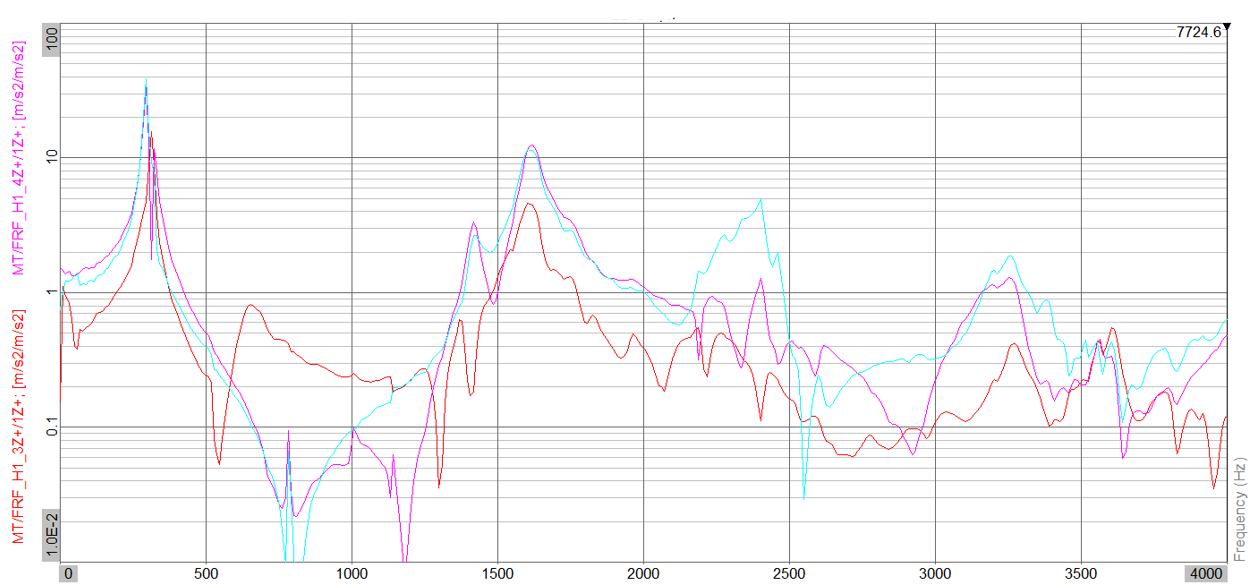Modal testing is a key component of ARC NVH Engineering Services. It is a widely used analysis method in the automotive NVH sector and others. In this blog post, we are going to discuss the basics of modal testing and why it is such a valuable NVH tool.
All structures exhibit vibrational modes at specific frequencies. The frequency and shape of these modes are defined by the mass, stiffness, damping and boundary conditions of the object under test. Modes are sometimes referred to as natural frequencies, as they are a characteristics of the structure.

The simplest vibration mode for us to visualise is a plate which is secured along the boundary edges. The first mode of this plate will consist of an anti-node (point of high displacement) in the centre. Higher frequency modes will also exist, which include multiple nodes (points of zero displacement) and anti-nodes.
It is important to understand the modal response of structures to prevent issues when excitation is applied. For example, we would want to know the modal behaviour of a vehicle subframe before a motor system (excitation) is installed within it. This is to avoid an effect known as resonance.
When a structures natural frequencies and the excitation applied to that structure match – we encounter resonance. This leads to high levels of vibration which can cause damage, failure or NVH issues.
This is where modal testing comes in. There are many ways to conduct a modal test, either using instrumented hammers or shaker systems. However, effectively we are simply applying a known force to the structure and measuring the vibration output.
Returning to the subframe example, we may decide to input the force at the motor mounting points, as this is where the load will be applied in real-world conditions. It would then be possible to measure the vibration output using an accelerometers at multiple points of the subframe and the attachment points to the vehicle body. This would provide a characterisation of the subframe modal response and the resonant peaks which are to be avoided by the forcing input. This is ideal for NVH applications.
When testing with an instrumented hammer, this will usually be fitted with a calibrated load cell. The output from this will usually be measured in Newtons (N). The response points will generally be accelerometers, with the output being measured in m/s-2. Once the results are processed, each measurement point will have a defined inertance in m/s-2/N.
Modal testing also allows us to characterise the shape of modes. This allows NVH Engineers to understand the movement of the structure at specific frequencies. In order to do this, we need to understand the phase response at each measurement point. This allows us to define the relative motion of measurement points and generation of mode-shape animations.

For specific NVH or Acoustic Engineering issues, modal testing can be extended to include Noise Transfer Functions (NTFs). In this case, we do not measure the vibration level at the response points, but the acoustic response. In the subframe example, we would again apply a force at the motor mounting points, however we would measure the acoustic response at the vehicle passenger ear positions. This allows NVH Engineers to understand the transfer of noise per input force between the motor and the listener. With an NTF, the results would normally be shown in units of dB/N.
For NVH Engineering purposes, NTFs have the added advantage that they will also include the effect of contribution from the vehicle cabin. This may be due to body sensitivities, cabin modal response or poor sealing systems.
Modal testing can also be used to calculate the stiffness of a panel. Usually, this would be in the form of Local Dynamic Stiffness (LDS). This is done by applying a known force and measuring (or reverse calculating) the resulting displacement. As measurements are usually taken with an accelerometer, the reverse calculation is usually done using integration. The result will be in the units of mm/N. This is helpful for NVH Engineers, as it can be used for benchmarking and target setting purposes.
We hope this blog post has provided an introduction to modal testing. If you feel that ARCs modal testing or NVH Engineering services can be of use, then please do not hesitate to contact us.
PINNED POSTS
No data found
BLOG CATEGORIES
No data found
